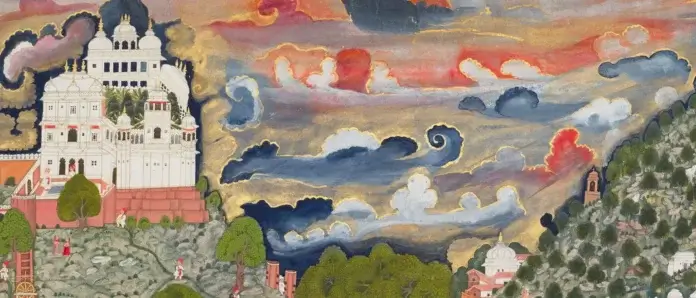Smithsonian’s National Museum of Asian Art Announces “A Splendid Land: Paintings from Royal Udaipur”
Exhibition Presents a New Way of Thinking About and Viewing Indian Paintings With Artworks That Reveal How Artists Conveyed Emotions and Ecologies in Groundbreaking Ways
The National Museum of Asian Art is presenting “A Splendid Land: Paintings from Royal Udaipur,” a major survey of works from the lake city of Udaipur in Rajasthan, India, Nov. 19–May 14, 2023. Presented in collaboration with The City Palace Museum in Udaipur administered by The Maharana of Mewar Charitable Foundation, the exhibition brings together 63 works on paper, cotton and scrolls from collections across the world to reveal how artists sought to convey the sensory and lived experience of the lake city. Many of the paintings have never been publicly exhibited or published. Curated by Debra Diamond (Elizabeth Moynihan Curator for South Asian and Southeast Asian Art at the National Museum of Asian Art) and Dipti Khera (associate professor at New York University), “A Splendid Land” will be on view in the museum’s Arthur M. Sackler Gallery. It is the first in a series of exhibitions that celebrate the National Museum of Asian Art’s centennial in 2023.
In the 18th century, the artists of Udaipur shifted their focus from small poetic manuscripts to large-scale paintings of the city’s palaces, lakes, mountains and seasons. They sought to convey the bhava, the emotional tenor and sensorial experiences, that make places and times memorable. This was unlike anything else in Indian art. The paintings express themes of belonging and prosperous futures that are universal. “A Splendid Land” explores the environmental, political and emotional contexts in which the new genre emerged. Udaipur’s economy depended on annual monsoons, extensive water harvesting and securing the loyalty of nobles and allies. By celebrating regional abundance and courtly refinement, the paintings strengthened friendships in the changing political landscapes of early modern South Asia.
“The National Museum of Asian Art has a rich history of connecting visitors with South Asian arts and cultures,” said Chase F. Robinson, Dame Jillian Sackler Director of the Arthur M. Sackler Gallery and Freer Gallery of Art. “Built upon a long-standing collaboration with Indian colleagues, the exhibition will allow the museum to bring extraordinary but little-known pieces to a global audience, enriching its understanding of a fascinating moment in India’s past.”
The National Museum of Asian Art has more than 1,200 objects in its South Asian collections. Sculpture, paintings and manuscripts illuminate the subcontinent’s many religious and courtly traditions; photography is at the center of the contemporary Indian holdings. “A Splendid Land” includes 13 paintings from the National Museum of Asian Art; paintings from Udaipur are a strength of the collection.
The artworks featured in the exhibition reveal how painters developed a new genre centered upon the lived experience of local landscapes, lake systems and palaces. The atelier became an incubator; over some 200 years, artists found ever-new ways to evoke ambience, trigger memories and create feelings of connection. This departure in subject matter differs from the body-focused visual traditions of Indian art over two millennia. “A Splendid Land” is the first exhibition to closely examine this shift and how it expands people’s understanding of emotions and sensorial experience, as well as climate and natural resource management, in early modern India.
“A Splendid Land” is organized as a journey that begins at Udaipur’s center and continues outward: first the lakes and lake palaces, then to the city, the countryside and finally to the cosmos. An ambient soundscape by the renowned experimental filmmaker Amit Dutta (b. 1977, Jammu, India) underscores the sensorial elements in the paintings, inviting contemporary audiences to sense—and not just see—the moods of these extraordinary places and paintings. The installation will include 51 works on paper (roughly 3 feet by 4 feet), five monumental works on cotton (ranging in height from 5 feet to 10 feet), one scroll (9 feet in length) from the 17th through 19th centuries and six photographs from the 19th and 20th centuries.
“The exhibition structure directly responds to the visuality of the paintings and the historical goals of the artists,” said Diamond, who is a specialist in Indian court painting. “Each gallery centers upon the emotions engendered by a particular place or season. The sequence of immersive moods will heighten the sensorial experience of place for museum visitors. I am grateful to the City Palace Museum for their partnership on this exciting project that allows our visitors to get a sense of Udaipur and its cultural heritage, and to co-curator Dipti Khera, whose groundbreaking work on historical emotions is central to the exhibition.”
Diamond has curated numerous exhibitions with the National Museum of Asian Art, including “Garden & Cosmos” (2008–9), “Yoga: The Art of Transformation” (2013–4) and “Body Image: Arts from the Indian Subcontinent,” currently on view in the museum’s Freer Gallery of Art. Khera, associate professor in New York University’s Department of Art History and Institute of Fine Arts, has published extensively, foregrounding art that challenges colonial perspectives and global histories of the 18th and 19th centuries.
“A Splendid Land” will be accompanied by a robust program of public events, most notably a public symposium on the monsoon, past and present, and the ways that art reveals cultural attitudes towards natural resources and speaks to climate crises in South Asia that will bring perspectives of the past together with insights of the future. Additionally, the traditional Rajasthani music band Raitila Rajasthan will present “Music of Splendid Land,” featuring songs inspired from themes of Udaipur paintings showcased at the exhibition.
Disclaimer: The Daily Brunch website does not own the copyrights to the featured image.





















